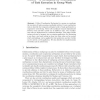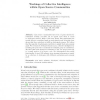2297 search results - page 10 / 460 » A Relational Model of How High-Performance Work Systems Work |
CSAC
2004
13 years 8 months ago
2004
CoMex (Coordination Mechanism) is a system to coordinate the execution of tasks accessing coordinable entities. It uses coordination rules to describe the temporal and logical orde...
ICFP
2004
ACM
14 years 7 months ago
2004
ACM
Useful type inference must be faster than normalization. Otherwise, you could check safety conditions by running the program. We analyze the relationship between bounds on normali...
HICSS
2007
IEEE
14 years 1 months ago
2007
IEEE
We studied 52 field examples interaction breakdown in information technology project virtual teams and actions leaders took to fix it using information and communication technolog...
SBP
2010
Springer
14 years 2 months ago
2010
Springer
Open source communities have been of great interest for researchers recently, yet little can be agreed upon when it comes to developers motives. While it has been shown that partic...
BIRTHDAY
2007
Springer
14 years 1 months ago
2007
Springer
Superdeduction is a systematic way to extend a deduction system like the sequent calculus by new deduction rules computed from the user theory. We show how this could be done in a ...


